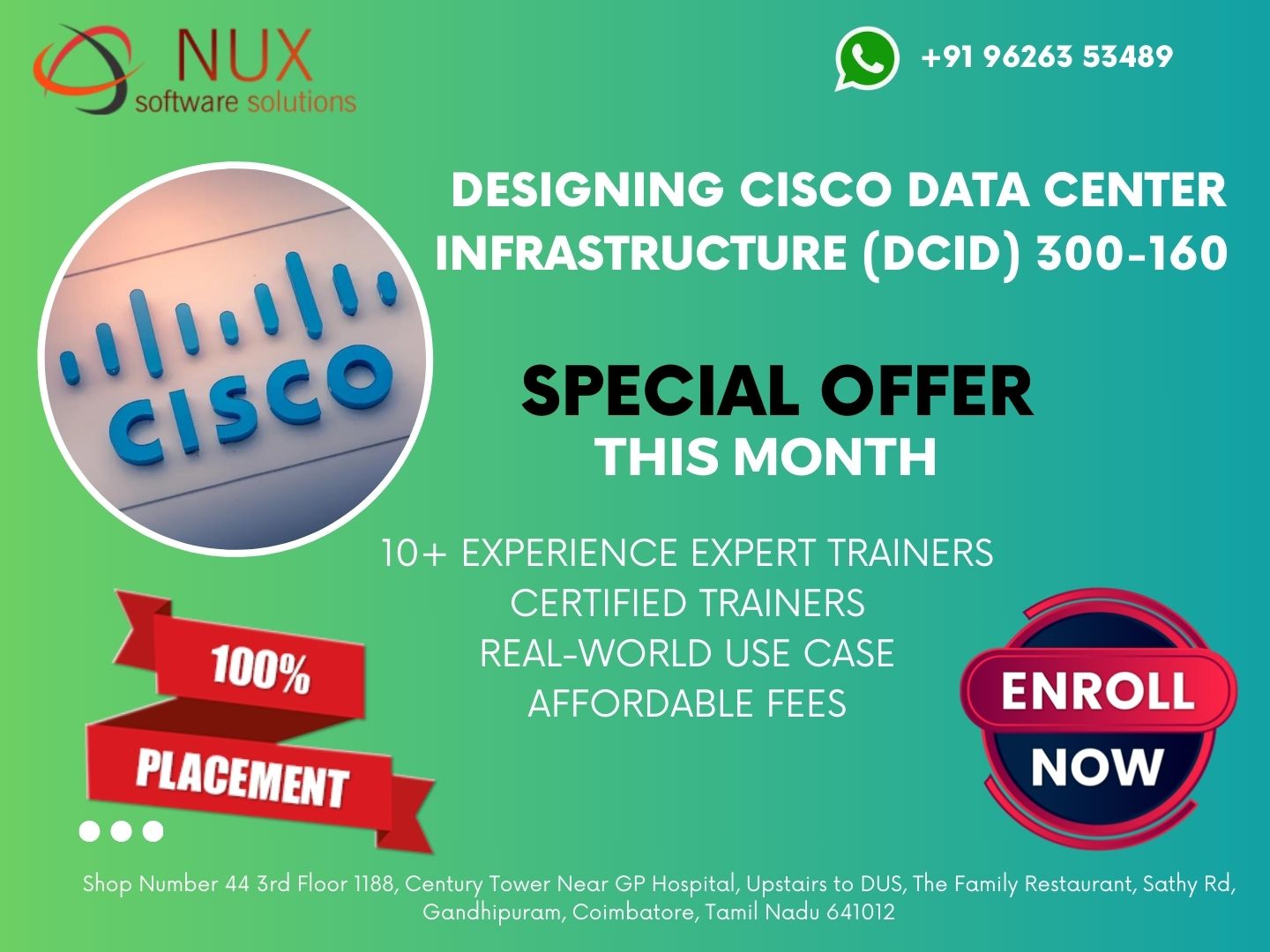Designing Cisco Data Center Infrastructure (DCID) – 300-610 Training and certifications

Designing Cisco Data Center Infrastructure (DCID 300-610) Training in Coimbatore
Course Overview
The Designing Cisco Data Center Infrastructure (DCID 300-610) course is a professional-level training designed to equip IT professionals with the skills to design and implement cutting-edge data center technologies using Cisco solutions. As a key concentration exam for the CCNP Data Center certification, this course focuses on translating business requirements into reliable, scalable, and secure data center designs.
At Linux Training Center in Coimbatore, we deliver this training through instructor-led classes, real-time design scenarios, and in-depth guidance to ensure learners can design modern Cisco-based data centers with confidence.
Why Choose DCID 300-610?
In today’s digital world, businesses depend heavily on efficient, highly available, and scalable data centers. The DCID certification validates your capability to design infrastructure that supports compute, networking, storage, automation, and virtualization—all integrated into a secure and robust environment.
Whether you’re a network design engineer or planning to advance in your career as a data center architect, this course provides the blueprint for high-performance data center environments using Cisco Nexus, UCS, and ACI technologies.
Who Should Enroll?
This course is suitable for:
-
Network Design Engineers and Architects
-
Data Center Engineers and Administrators
-
IT Infrastructure Professionals
-
Cloud and Virtualization Engineers
-
Candidates pursuing the CCNP Data Center certification
A solid understanding of data center fundamentals, Layer 2/Layer 3 networking, and virtualization concepts is recommended.
What You Will Learn
-
Data center network design with Cisco Nexus switching platforms
-
Layer 2 and Layer 3 fabric design, including spine-leaf architecture
-
Designing software-defined networking with Cisco ACI
-
Storage network design using Cisco MDS and SAN technologies
-
Compute platform design with Cisco UCS and server virtualization
-
Integration of automation and orchestration into infrastructure
-
Business continuity and high availability design strategies
-
Security considerations and policy frameworks in the data center
-
Best practices for scalability, modularity, and operations
Through design case studies and real-world scenarios, you’ll gain the critical thinking and strategic approach needed to architect future-ready data centers.
Course Highlights
-
Training led by Cisco-certified infrastructure architects
-
Real-world data center design case studies
-
Access to Cisco labs for practical experience
-
Complete coverage of the DCID 300-610 exam blueprint
-
Training modes: online, weekday, or weekend sessions
-
Expert mentoring for certification and design career paths
Career Opportunities
On completing this course, you can pursue roles such as Data Center Architect, Solutions Design Engineer, Infrastructure Consultant, Cloud Network Designer, or Cisco Technology Specialist. It is also a required concentration exam for the CCNP Data Center certification path.
Why Linux Training Center?
Linux Training Center in Coimbatore stands out for delivering industry-aligned training programs tailored for real-world success. Our DCID training ensures that you’re not only prepared to pass the exam but also to design enterprise-grade data centers that deliver agility, security, and resilience.
Designing Cisco Data Center Infrastructure (DCID) – 300-610 Syllabus
1.0 Network Design
- 1.1.a Endpoint mobility
- 1.1.b Redundancy/high availability
- 1.1.c Convergence
- 1.1.d Services insertion
- 1.2.a IP mobility
- 1.2.b Redundancy / high availability (graceful restart, NSF)
- 1.2.c Convergence
- 1.2.d Services insertion (load balancing, security)
2.0 Compute Design
- 2.1.a Redundancy / high availability
- 2.1.b Bandwidth (oversubscription)
- 2.1.c Fabric interconnect operation mode (switch mode, end host mode)
- 2.2.a Bandwidth (port-channels, oversubscription)
- 2.2.b Fabric interconnect operation mode (switch mode, end host mode)
- 2.2.c Direct-attached storage (appliance, FC storage, and FCoE ports)
- 2.3.a Service profiles
- 2.3.b vCon placement policies
- 2.3.c Ethernet adaptor policies
- 2.3.d Fibre Channel adapter policies
- 2.4.a Cluster mode
- 2.4.b HX for virtual server
- 2.4.c Desktop virtualization
3.0 Storage Network Design
- 3.2.a Fibre Channel
- 3.2.b FCoE
- 3.2.c FCIP
- 3.2.d iSCSI
- 3.3.a Port types
- 3.3.b ISL
- 3.3.c Oversubscription
4.0 Automation Design
- 4.1.a Cisco Nexus Dashboard Fabric Controller
- 4.1.b Cisco Intersight
- 4.1.c REST API (NX-API, JSON encoding, and XML encodings)
- 4.1.d Model-driven programmability
- 4.1.e Ansible
- 4.1.f Python
- 4.2.a Service profile templates
- 4.2.b vNIC templates
- 4.2.c vHBA templates
- 4.2.d Global policies vs. local policies



